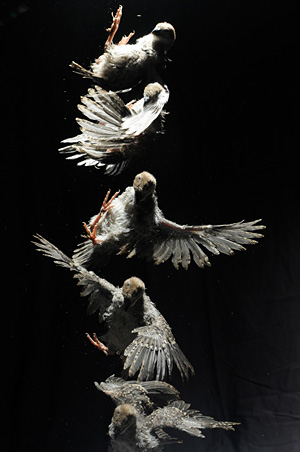Why Do Baby Birds Flap Their Wings Fast When Being Fed
How did the earliest birds take wing? Did they autumn from trees and acquire to flap their forelimbs to avoid crashing? Or did they run along the footing and pump their "arms" to get aloft?
The answer is buried 150 million years in the past, but a new University of California, Berkeley, written report provides a new piece of evidence – birds have an innate ability to maneuver in midair, a talent that could have helped their ancestors learn to fly rather than fall from a perch.

A nine 24-hour interval-old chukar chick righting itself using disproportionate wing flapping and rolling afterwards being dropped upside down. Dennis Evangelista photos.
The study looked at how baby birds, in this example chukar partridges, pheasant-like game birds from Eurasia, react when they fall upside downwards.
The researchers, Dennis Evangelista, now a postdoctoral researcher at the University of Northward Carolina, Chapel Hill, and Robert Dudley, UC Berkeley professor of integrative biological science, establish that fifty-fifty ungainly, day-former infant birds successfully use their flapping wings to correct themselves when they fall from a nest, a skill that improves with age until they go coordinated and svelte flyers.
"From day one, post-hatching, 25 percent of these birds can basically roll in midair and land on their feet when y'all drop them," said Dudley, who too is affiliated with the Smithsonian Tropical Research Institute in Balboa, Panama. "This suggests that even rudimentary wings can serve a very useful aerodynamic purpose."
Flapping and rolling
The nestlings right themselves by pumping their wings asymmetrically to flip or roll. By nine days after hatching, 100 percentage of the birds in the study had adult coordinated or symmetric flapping, plus body pitch command to right themselves.
"These abilities develop very apace after hatching, and occur earlier other previously described uses of the wings, such as for weight support during wing-assisted incline running," said Evangelista, who emphasized that no chukar chicks were injured in the process. "The results highlight the importance of maneuvering and control in development and evolution of flying in birds."
The researchers' study appeared Aug. 27 in the online journal Biology Messages, published past the Regal Club.
Dudley has argued for a decade that midair maneuverability preceded the development of flapping flight and allowed the ancestors of today's birds to effectively utilize their forelimbs as rudimentary wings. The new study shows that aerial righting using uncoordinated, asymmetric wing flapping is a very early evolution.
Righting behavior probably evolved because "nobody wants to be upside down, and information technology's particularly dangerous if you're falling in midair," Dudley said. "Merely in one case animals without wings accept this innate aerial righting beliefs, when wings came forth information technology became easier, quicker and more efficient."
Dudley noted that some scientists hypothesize that true powered flight originated in the theropod dinosaurs, the ancestors to birds, when they used symmetric fly flapping while running up an incline, a behavior known as fly-assisted incline running, or WAIR. WAIR proponents debate that the wings assist running by providing lift, like the spoiler on a race machine, and that the ability to steer or maneuver is absent early in evolution.
Falling, gliding and flying
Such activity has never been regularly observed in nature, however, and Dudley favors the scenario that flight developed in tree-dwelling animals falling and eventually evolving the power to glide and fly. He has documented many means that animals in the wild, from lizards and lemurs to ants, use various parts of their bodies to avoid hard landings on the ground. Practically every fauna that has been tested is able to turn upright, and a corking many, even ones that do not wait like fliers, have some ability to steer or maneuver in the air.

Chukar partridge chick 1-2 days later hatching.
Contrary to WAIR, maneuvering is very important at all stages of flight evolution and must have been present early, Evangelista said. Seeing it develop starting time in very young chicks indirectly supports this idea.
"Symmetric flapping while running is certainly one possible context in which rudimentary wings could have been used, just information technology kicks in rather late in development relative to asymmetric flapping," Dudley added. "This experiment illustrates that there is a much broader range of aerodynamic chapters available for animals with these tiny, tiny wings than has been previously realized."
The researchers too tested the young chicks to run across if they flapped their wings while running up an incline. None did.
Three former UC Berkeley undergraduates – Sharlene Cam, Tony Huynh and Igor Krivitskiy – worked with Evangelista and Dudley through the Undergraduate Research Apprentice Program (URAP) and are coauthors on the Biology Letters paper. Evangelista was supported past a National Science Foundation Integrative Graduate Pedagogy and Research Traineeship (IGERT #DGE-0903711) grant and by grants from the Berkeley Sigma 11 chapter and the national Sigma Xi.
RELATED Information
- Ontogenesis of aerial righting and wing flapping in juvenile birds (Biology Messages)
- Dennis Evangelista'south website
- Robert Dudley's Animal Flight Laboratory
Source: https://news.berkeley.edu/2014/08/28/flapping-baby-birds-give-clues-to-origin-of-flight/
0 Response to "Why Do Baby Birds Flap Their Wings Fast When Being Fed"
Post a Comment